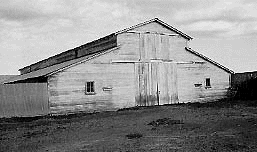Historic Architectural Survey of Bowman County
Sheep Country
When North Dakotans think of ranching, they think of cattle, but southwestern North Dakota has been home to a substantial sheep industry since the 1880s, and important elements of its later material culture still grace the Bowman County landscape.
 | For instance, in the southwest part of the county stands this L-shaped barn so large it can hardly be captured in a photograph. Unlike most sheep barns, a key purpose of which is lambing, this barn built in the 1940s has a simple gable roof, but notice that it is a fairly low gable; for these lambing barns, loft space was not particularly important. |
| Here we have an older sheep barn, dating from the first decade of the century, of a design found nowhere else in the county. It is a long, low building with a semi-monitor roof, windows on the lower and roof levels facing south. This building was meant to gather light and heat during early spring lambing. Situated on an abandoned ranch site, the building unfortunately has fallen into serious disrepair. |  |
 | The more typical design for a sheep barn incorporated a monitor roof, such as is seen at left, an example dating from about 1910. This roof type promotes ventilation and provides modest loft space for hay. Shed-roofed extensions or additions along the long sides bring additional floor space under shelter. |
| The same basic design, with a somewhat lower loft, is seen in the example at right dating from about 1950. This well-constructed barn is located on the Burdett ranch near Bowman. |  |
 Center for Heritage Renewal
Center for Heritage Renewal
|